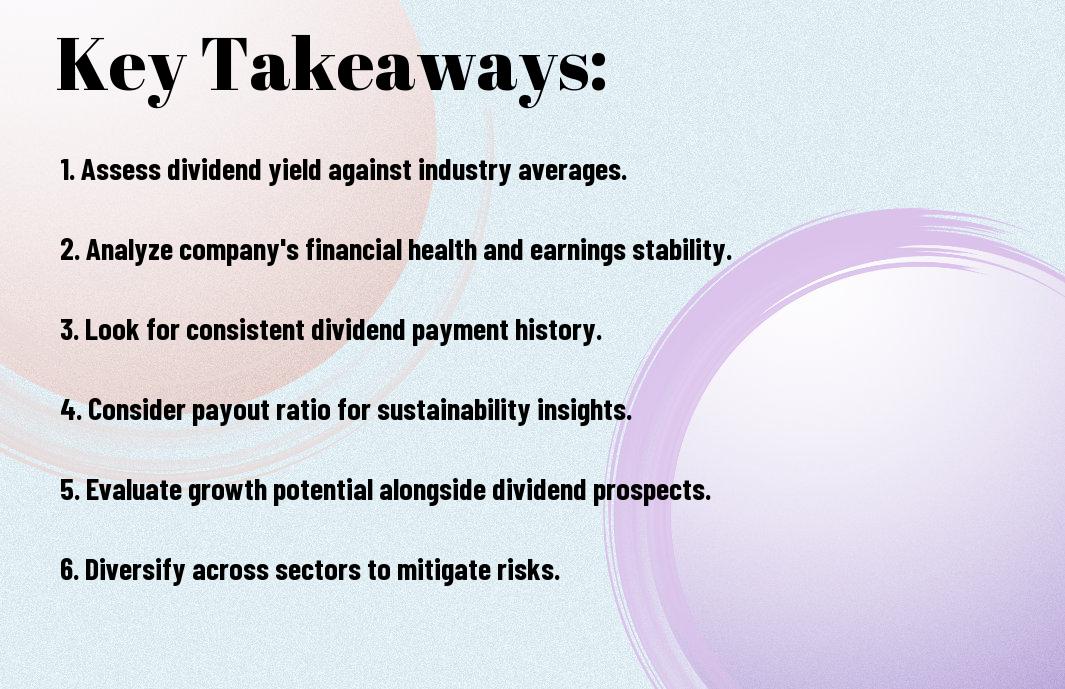Dividends can play a significant role in building your investment portfolio, especially when you utilize Dividend Reinvestment Plans (DRIPs). By automatically reinvesting your dividends, you can benefit from compound growth and potentially increase your returns over time. In this post, you’ll learn how DRIPs can enhance your overall investment strategy, providing you with a cost-effective way to grow your wealth while minimizing your need to monitor the market constantly. Dive in to discover how these plans can benefit your financial future.

Key Takeaways:
- Compounding Growth: DRIPs allow investors to reinvest dividend payments, leading to exponential growth in shares over time as more shares are purchased with dividends.
- Cost Efficiency: Many DRIPs offer the ability to buy shares without paying commission fees, enabling investors to maximize their investments without additional costs.
- Long-Term Investment Strategy: DRIPs encourage a long-term investment mindset, helping investors to stay focused on potential growth rather than short-term market fluctuations.

Understanding Dividend Reinvestment Plans (DRIPs)
While investing can seem complex, Dividend Reinvestment Plans (DRIPs) provide a straightforward method for growing your wealth. By automatically reinvesting dividends back into additional shares of stock, you can enhance the compounding effect and potentially increase your overall investment returns over time. Understanding how DRIPs function can help you make informed decisions about your investment strategy.
What Are DRIPs?
About DRIPs, or Dividend Reinvestment Plans, are programs offered by companies that allow you to reinvest your cash dividends into additional shares of stock automatically. This option helps you accumulate more shares without incurring brokerage fees, thereby allowing you to grow your investment continuously. Many investors find DRIPs an effective way to enhance their portfolio’s value over time.
How DRIPs Work
DRIPs enable you to reinvest dividends directly into your stock, rather than receiving them in cash. By enrolling in a DRIP, you authorize the company to use your dividends to purchase additional shares, sometimes even fractions of shares, at a potentially discounted price. This process helps you acquire more ownership in the company without worrying about transaction costs.
At the heart of DRIPs is the power of compounding. By reinvesting your dividends, you buy more shares, which in turn generate more dividends. Over time, this cycle can significantly boost the total number of shares you own, increasing your investment’s potential for long-term growth. Not only does this strategy enhance your returns, but it also allows you to leverage your investments efficiently without actively managing each transaction.
Financial Benefits of DRIPs
There’s a myriad of financial advantages that come with Dividend Reinvestment Plans (DRIPs). By allowing your dividends to automatically purchase additional shares, your investment can grow exponentially over time. This strategy not only increases your ownership in the company but also enhances the potential for future returns as those shares produce their own dividends. The simplicity and automation associated with DRIPs make them an appealing option for investors looking to build long-term wealth.
Compounding Returns
Compounding is one of the most powerful concepts in investing. When you reinvest your dividends, you’re effectively buying more shares, which in turn generate additional dividends. Over time, this cycle accelerates the growth of your investment, allowing not just your initial principal to work for you, but also the dividends from the additional shares. This phenomenon can significantly boost your portfolio’s value, especially in the long run.
Cost-Effective Investment
For many investors, cost is a significant factor when considering investment options. DRIPs often have low or no transaction fees, making it easier for you to reinvest without incurring extra costs. This feature aligns well with long-term investment strategies, allowing you to maximize your financial returns without the burden of high fees.
Even small savings on transaction fees can lead to substantial increases in your overall returns when considering the long-term effects of compounding. By eliminating or reducing these costs, DRIPs empower you to invest a more significant portion of your dividends directly back into your portfolio. This cost-effective approach means more money at work in the market, allowing you to accumulate wealth more efficiently over time.
Tax Advantages of DRIPs
Now that you understand the basic concepts of Dividend Reinvestment Plans (DRIPs), it’s important to consider the tax advantages they offer. Utilizing DRIPs can be a smart strategy for building wealth, as your investments can grow without the immediate tax burden that often accompanies dividend payouts. By keeping your money reinvested, you can optimize your investment approach while potentially lowering your overall tax liability.
Tax Deferral
The key benefit of tax deferral in DRIPs is that you don’t incur taxes on dividends until you sell the shares. This allows your investment to grow exponentially since you can reinvest the full amount of your dividends without deductions for taxes immediately. You can benefit from compounding over time, resulting in a larger capital base for future growth.
Capital Gains Considerations
Above all, DRIPs can help you manage capital gains more effectively than traditional dividend payouts. When you reinvest dividends into additional shares, you delay the realization of taxable capital gains until you decide to sell. This delay can provide greater flexibility when it comes to tax planning and strategies aimed at minimizing tax impact.
Another aspect of capital gains considerations is that when you eventually sell your DRIP shares, your capital gains will be based on the difference between your selling price and the purchase price of the shares, not the dividends you reinvested. This can lead to a more favorable tax situation, especially if you’ve held your shares long enough to qualify for lower long-term capital gains tax rates. This strategy can support your overall investment goals while providing an efficient way to handle taxes related to your growing portfolio.
Long-Term Investment Strategy
Many investors find that a long-term investment strategy using DRIPs 101: A Guide to Dividend Reinvestment Plans can foster wealth accumulation over time. By automatically reinvesting dividends, you benefit from compounding returns, which can significantly enhance your portfolio’s growth. This disciplined approach allows you to take advantage of market fluctuations and build equity without the emotional stress often associated with investing.
Building a Diversified Portfolio
Around your investment goals, a DRIP can help you build a diversified portfolio by allowing you to invest in multiple dividend-paying stocks systematically. Diversification is key to managing risk, and DRIPs enable you to spread your investments across various sectors and industries, enhancing your chances of long-term success while maintaining a steady flow of income.
Enhancing Investment Discipline
Beside the benefits of compounding, DRIPs encourage a disciplined investment approach. By automating your investments, you are less likely to fall victim to market swings, emotional trading, or knee-jerk reactions to news. This commitment to a systematic investment schedule allows you to remain focused on your long-term financial goals without being sidetracked by short-term market conditions.
With disciplined investing, you consistently contribute to your portfolio, regardless of market performance. This regular investment pattern fosters a stable growth mindset, where you prioritize accumulation over speculation. Over time, this practice not only helps mitigate risks associated with market volatility but also builds your confidence as you witness your investments flourish, paving the way for achieving your financial aspirations.
Risks and Considerations
Not all investment vehicles come without risks. While Dividend Reinvestment Plans (DRIPs) offer many advantages, you should also consider potential drawbacks. It’s crucial to evaluate The Pros and Cons of DRIP Plans and DRIP Stocks before plunging into this investment strategy.
Market Risks
Before you commit to a DRIP, be aware that market fluctuations can affect the value of your investments. While reinvesting dividends can compound your growth over time, a downturn in the stock market may impact the overall performance of the stock you hold.
Withdrawal Limitations
Between the benefits of DRIPs, there are also limitations on your ability to withdraw funds when needed. You may find that selling shares to access cash can be less straightforward due to specific rules governing these plans.
It is important to understand that some DRIPs require you to hold onto your shares for a certain period, potentially affecting your liquidity. Additionally, you may face transaction fees and delays when selling shares, making it crucial to plan your finances accordingly before fully committing to a DRIP strategy.
Choosing the Right DRIP
Keep in mind that selecting the right Dividend Reinvestment Plan (DRIP) requires careful consideration. You should look at factors such as the company’s financial health, historical performance, and your investment goals. By evaluating various options, you can find a plan that aligns with your long-term strategy and maximizes returns while minimizing risk.
Evaluating Companies
Companies with a strong track record of consistent dividends are your best choice for DRIPs. Analyze their financial statements, dividend history, and market position to ensure you are investing in a reliable entity. A history of stable or increasing dividends is often a good indicator of a robust business model.
Assessing Fees and Policies
On your journey to invest wisely, you need to investigate the fees and policies associated with each DRIP. Look out for enrollment fees, transaction costs, and potential penalties. Understanding these aspects not only affects your overall returns but also your investment experience.
Right from the start, the fees associated with a DRIP can make a significant difference in your investment outcomes. Ensure you read the plan’s terms thoroughly and consider any costs that might chip away at your dividends. Assess policies regarding reinvestment frequency and flexibility in terms of opt-out options. By being well-informed, you’ll be equipped to make a decision that enhances your portfolio’s potential growth.
Final Words
Presently, Dividend Reinvestment Plans (DRIPs) offer you a powerful strategy for growing your investment portfolio. By automatically reinvesting dividends, you can take advantage of compounding returns without incurring additional transaction fees. This approach not only enhances your long-term wealth but also helps you build a more substantial position in your chosen companies. Utilizing DRIPs can thus simplify your investing process, allowing your money to work harder for you over time, ultimately leading to greater financial security and potential for retirement. Explore the benefits of DRIPs and make them a part of your investing journey.
FAQ
Q: What are Dividend Reinvestment Plans (DRIPs) and how do they work?
A: Dividend Reinvestment Plans (DRIPs) allow investors to reinvest their cash dividends into additional shares of the stock, instead of receiving the dividends as cash payouts. This process typically occurs automatically, enabling investors to purchase fractional shares without incurring commission fees. By reinvesting dividends, investors can take advantage of compound growth over time, as the additional shares generate their own dividends, creating a snowball effect that can significantly increase the total value of an investment.
Q: What are the advantages of using DRIPs for long-term investment strategies?
A: One of the primary advantages of using DRIPs in long-term investment strategies is the potential for compounding returns. Since dividends are reinvested to buy more shares, investors can benefit from both the appreciation of the stock value and the accumulation of dividends. Additionally, DRIPs often require less initial capital since fractional shares can be purchased. Furthermore, many companies offer DRIPs with little to no fees, making it a cost-effective way to build a larger position in a company over time, even during market fluctuations.
Q: Are there any downsides to participating in DRIPs?
A: While DRIPs can be beneficial, there are some potential downsides to consider. First, by reinvesting dividends, investors might miss out on the flexibility of having cash available for other opportunities, including reinvesting in different stocks or paying off debt. Furthermore, purchasing additional shares through DRIPs could lead to concentrated positions in a single stock, increasing overall investment risk. Lastly, investors should be aware of tax implications since dividends, even if reinvested, are considered taxable income in the year they are declared.


